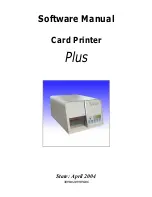
14
Elements of Card Design
Printing Design
Color Printing
Color
ribbon
is
available
in
full
‐
panel
and
short
‐
panel
styles.
Full-Panel Ribbon
Full
‐
panel
color
printing
uses
a
ribbon
with
three
color
panels:
Y
(yellow),
M (magenta),
and
C
(cyan).
The
ribbon
also
includes
a
K
(black)
panel
and
a
T
(topcoat)
panel.
The
printer
applies
the
YMC
color
panels
to
the
card
first,
prints
black
components
using
the
K
panel,
and
then
applies
the
T
(topcoat)
to
protect
the
color
image
from
damage.
Laminating
printers
support
full
‐
color
ribbons
without
a
topcoat
(T)
panel.
These
include
YMCK
and
YMCKK
ribbon.
The
topcoat
or
patch
overlay
applied
by
the
laminators
provides
protection
against
wear
and
color
fading,
so
the
ribbon
topcoat
panel
is
not
needed
for
most
overlay
materials.
However,
DuraShield
overlay
materials
require
that
the
ribbon
topcoat
be
applied
first.
Laminating
printers
also
support
full
‐
color
ribbon
with
a
front
‐
side
ultraviolet
(UV)
fluorescing
panel,
YMCKF
‐
KT.
The
UV
printing
is
undetectable
under
normal
lighting
and
is
meant
to
provide
another
form
of
security.
Refer
to
your
printer’s
Driver
Guide
for
more
information
about
setting
up
a
card
design
that
uses
the
UV
panel.
Short-Panel Ribbon
Color
ribbon
also
is
available
in
a
short
‐
panel
option.
The
color
area
for
short
‐
panel
ribbon
is
1.57
inches
(40
mm).
The
ymc
panels
of
short
‐
panel
ribbon
are
approximately
half
the
length
of
a
full
card.
(In
this
guide,
“ymc”
in
lowercase,
instead
of
“YMC,”
refers
to
“short
‐
panel”
color
panels.)
When
you
with
short
‐
panel
ribbon,
you
define
the
location
of
the
color
area
in
the
card
design.
Color
printing
begins
when
the
software
detects
a
color
pixel
and
continues
for
the
length
of
the
ymc
panels.
Содержание SD260
Страница 4: ...iv...
Страница 38: ...30 Elements of Card Design...
Страница 100: ...92 Supplies and Parts...
Страница 116: ...A 16 SD460 Laminating System...
















































